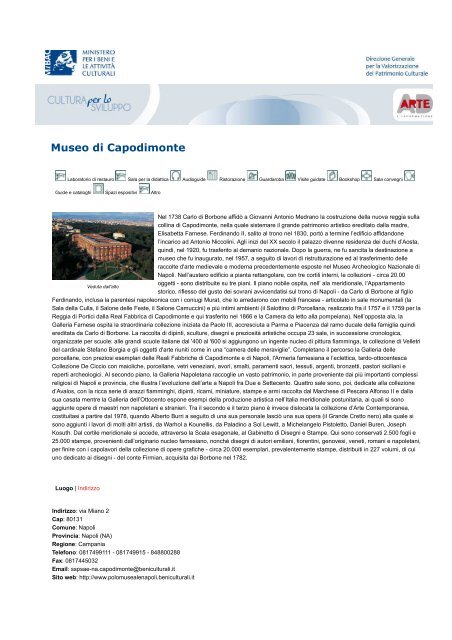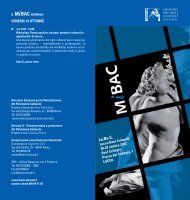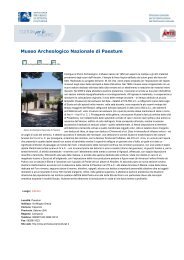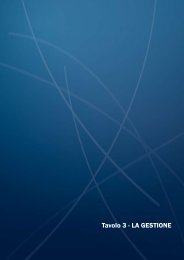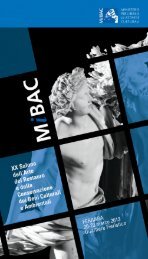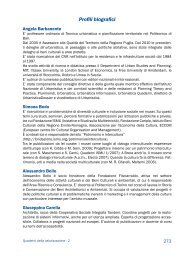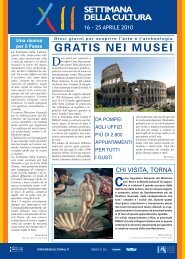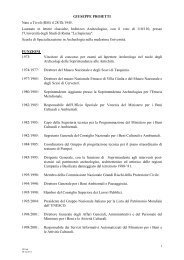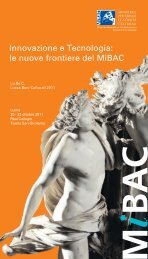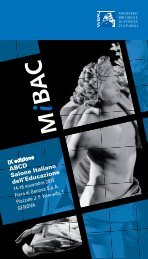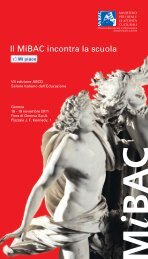Museo di Capodimonte - Direzione Generale per la Valorizzazione ...
Museo di Capodimonte - Direzione Generale per la Valorizzazione ...
Museo di Capodimonte - Direzione Generale per la Valorizzazione ...
Create successful ePaper yourself
Turn your PDF publications into a flip-book with our unique Google optimized e-Paper software.
<strong>Museo</strong> <strong>di</strong> Capo<strong>di</strong>monteLaboratorio <strong>di</strong> restauro Sa<strong>la</strong> <strong>per</strong> <strong>la</strong> <strong>di</strong>dattica Au<strong>di</strong>oguide Ristorazione Guardaroba Visite guidate Bookshop Sa<strong>la</strong> convegniGuide e cataloghi Spazi espositivi AltroNel 1738 Carlo <strong>di</strong> Borbone affidò a Giovanni Antonio Medrano <strong>la</strong> costruzione del<strong>la</strong> nuova reggia sul<strong>la</strong>collina <strong>di</strong> Capo<strong>di</strong>monte, nel<strong>la</strong> quale sistemare il grande patrimonio artistico ere<strong>di</strong>tato dal<strong>la</strong> madre,Elisabetta Farnese. Fer<strong>di</strong>nando II, salito al trono nel 1830, portò a termine l’e<strong>di</strong>ficio affidandonel’incarico ad Antonio Niccolini. Agli inizi del XX secolo il pa<strong>la</strong>zzo <strong>di</strong>venne residenza dei duchi d’Aosta,quin<strong>di</strong>, nel 1920, fu trasferito al demanio nazionale. Dopo <strong>la</strong> guerra, ne fu sancita <strong>la</strong> destinazione amuseo che fu inaugurato, nel 1957, a seguito <strong>di</strong> <strong>la</strong>vori <strong>di</strong> ristrutturazione ed al trasferimento delleraccolte d'arte me<strong>di</strong>evale e moderna precedentemente esposte nel <strong>Museo</strong> Archeologico Nazionale <strong>di</strong>Napoli. Nell’austero e<strong>di</strong>ficio a pianta rettango<strong>la</strong>re, con tre cortili interni, le collezioni - circa 20.00oggetti - sono <strong>di</strong>stribuite su tre piani. Il piano nobile ospita, nell’ a<strong>la</strong> meri<strong>di</strong>onale, l’AppartamentoVeduta dall'altostorico, riflesso del gusto dei sovrani avvicendatisi sul trono <strong>di</strong> Napoli - da Carlo <strong>di</strong> Borbone al figlioFer<strong>di</strong>nando, inclusa <strong>la</strong> parentesi napoleonica con i coniugi Murat, che lo arredarono con mobili francese - artico<strong>la</strong>to in sale monumentali (<strong>la</strong>Sa<strong>la</strong> del<strong>la</strong> Cul<strong>la</strong>, il Salone delle Feste, il Salone Camuccini) e più intimi ambienti (il Salottino <strong>di</strong> Porcel<strong>la</strong>na, realizzato fra il 1757 e il 1759 <strong>per</strong> <strong>la</strong>Reggia <strong>di</strong> Portici dal<strong>la</strong> Real Fabbrica <strong>di</strong> Capo<strong>di</strong>monte e qui trasferito nel 1866 e <strong>la</strong> Camera da letto al<strong>la</strong> pompeiana). Nell’opposta a<strong>la</strong>, <strong>la</strong>Galleria Farnese ospita <strong>la</strong> straor<strong>di</strong>naria collezione iniziata da Paolo III, accresciuta a Parma e Piacenza dal ramo ducale del<strong>la</strong> famiglia quin<strong>di</strong>ere<strong>di</strong>tata da Carlo <strong>di</strong> Borbone. La raccolta <strong>di</strong> <strong>di</strong>pinti, sculture, <strong>di</strong>segni e preziosità artistiche occupa 23 sale, in successione cronologica,organizzate <strong>per</strong> scuole: alle gran<strong>di</strong> scuole italiane dal '400 al '600 si aggiungono un ingente nucleo <strong>di</strong> pittura fiamminga, <strong>la</strong> collezione <strong>di</strong> Velletridel car<strong>di</strong>nale Stefano Borgia e gli oggetti d'arte riuniti come in una “camera delle meraviglie”. Completano il <strong>per</strong>corso <strong>la</strong> Galleria delleporcel<strong>la</strong>ne, con preziosi esemp<strong>la</strong>ri delle Reali Fabbriche <strong>di</strong> Capo<strong>di</strong>monte e <strong>di</strong> Napoli, l'Armeria farnesiana e l’eclettica, tardo-ottocentescaCollezione De Ciccio con maioliche, porcel<strong>la</strong>ne, vetri veneziani, avori, smalti, paramenti sacri, tessuti, argenti, bronzetti, pastori siciliani ere<strong>per</strong>ti archeologici. Al secondo piano, <strong>la</strong> Galleria Napoletana raccoglie un vasto patrimonio, in parte proveniente dai più importanti complessireligiosi <strong>di</strong> Napoli e provincia, che illustra l’evoluzione dell’arte a Napoli fra Due e Settecento. Quattro sale sono, poi, de<strong>di</strong>cate al<strong>la</strong> collezioned’Avalos, con <strong>la</strong> ricca serie <strong>di</strong> arazzi fiamminghi, <strong>di</strong>pinti, ricami, miniature, stampe e armi raccolta dal Marchese <strong>di</strong> Pescara Alfonso II e dal<strong>la</strong>sua casata mentre <strong>la</strong> Galleria dell’Ottocento espone esempi del<strong>la</strong> produzione artistica nell’Italia meri<strong>di</strong>onale postunitaria, ai quali si sonoaggiunte o<strong>per</strong>e <strong>di</strong> maestri non napoletani e stranieri. Tra il secondo e il terzo piano è invece <strong>di</strong>slocata <strong>la</strong> collezione d’Arte Contemporanea,costituitasi a partire dal 1978, quando Alberto Burri a seguito <strong>di</strong> una sua <strong>per</strong>sonale <strong>la</strong>sciò una sua o<strong>per</strong>a (il Grande Cretto nero) al<strong>la</strong> quale sisono aggiunti i <strong>la</strong>vori <strong>di</strong> molti altri artisti, da Warhol a Kounellis, da Pa<strong>la</strong><strong>di</strong>no a Sol Lewitt, a Miche<strong>la</strong>ngelo Pistoletto, Daniel Buren, JosephKosuth. Dal cortile meri<strong>di</strong>onale si accede, attraverso <strong>la</strong> Sca<strong>la</strong> esagonale, al Gabinetto <strong>di</strong> Disegni e Stampe. Qui sono conservati 2.500 fogli e25.000 stampe, provenienti dall’originario nucleo farnesiano, nonché <strong>di</strong>segni <strong>di</strong> autori emiliani, fiorentini, genovesi, veneti, romani e napoletani,<strong>per</strong> finire con i capo<strong>la</strong>vori del<strong>la</strong> collezione <strong>di</strong> o<strong>per</strong>e grafiche - circa 20.000 esemp<strong>la</strong>ri, prevalentemente stampe, <strong>di</strong>stribuiti in 227 volumi, <strong>di</strong> cuiuno de<strong>di</strong>cato ai <strong>di</strong>segni - del conte Firmian, acquisita dai Borbone nel 1782.Luogo | In<strong>di</strong>rizzoIn<strong>di</strong>rizzo: via Miano 2Cap: 80131Comune: NapoliProvincia: Napoli (NA)Regione: CampaniaTelefono: 0817499111 - 081749915 - 848800288Fax: 0817445032Email: sspsae-na.capo<strong>di</strong>monte@beniculturali.itSito web: http://www.polomusealenapoli.beniculturali.it
Veduta dall'alto Faccata principale Salottino <strong>di</strong> Porcel<strong>la</strong>na Simone Martini-San Ludovico da TolosaADArte | Sintesi <strong>di</strong> accesibilitàInformazioni raccolte con un sopralluogo terminato il 26 novembre 2011Il <strong>Museo</strong> <strong>di</strong> Capo<strong>di</strong>monte si trova all’interno del<strong>la</strong> Reggia <strong>di</strong> Capo<strong>di</strong>monte. Per raggiungere il <strong>Museo</strong> si deve attraversare il Parco del<strong>la</strong>Reggia, a cui si accede da tre ingressi <strong>di</strong>stinti, l'ingresso principale è su Via Miano numero 2. L’entrata che è anche l’uscita del<strong>la</strong> Reggia,sede del <strong>Museo</strong>, è un cancello che conduce ad un cortile interno al pa<strong>la</strong>zzo, in parte porticato.I piani a<strong>per</strong>ti al pubblico sono sei e cioè: il piano interrato, il piano terra, il piano ammezzato, il piano primo, il piano secondo ed il terzo.Al piano interrato c’è <strong>la</strong> Sa<strong>la</strong> Causa, che ospita mostre temporanee. Al piano terra ci sono <strong>la</strong> caffetteria, <strong>la</strong> biglietteria del <strong>Museo</strong> che èanche bookshop, <strong>la</strong> biglietteria e l’ingresso <strong>per</strong> <strong>la</strong> Sa<strong>la</strong> Causa, l’entrata allo Spazio Lewitt, <strong>la</strong> Sa<strong>la</strong> Conferenze e l’atrio <strong>di</strong> ingresso almuseo. Al piano ammezzato ci sono due sale dello Spazio Lewitt che sono sede <strong>di</strong> esposizioni temporanee. Al piano primo ci sono ventiduesale espositive del<strong>la</strong> Collezione Farnese e quattor<strong>di</strong>ci dell’Appartamento Reale. Al piano secondo ci sono trentotto sale espositive del<strong>la</strong>Galleria Napoletana, quattro sale del<strong>la</strong> sezione Collezione d'Avalos, <strong>la</strong> sa<strong>la</strong> Galleria Arazzi d’Avalos e quattro sale del<strong>la</strong> Sezione ArteContemporanea. In corrispondenza dell’ingresso a questa sezione c’è una rampa con pendenza del 10%. Al piano terzo ci sono: <strong>la</strong>Passerel<strong>la</strong> Jo<strong>di</strong>ce, <strong>la</strong> Galleria dell’ottocento e tre sale del<strong>la</strong> Sezione Arte Contemporanea, qui <strong>per</strong> passare dal<strong>la</strong> Sa<strong>la</strong> Polke al<strong>la</strong> Sa<strong>la</strong>Kosuth ci sono due gra<strong>di</strong>ni oppure una rampa inclinata con pendenza del 22.5%. Anche in prossimità dell’accesso al<strong>la</strong> Passerel<strong>la</strong> Jo<strong>di</strong>cec’è una rampa inclinata del 13% e, subito dopo, tre gra<strong>di</strong>ni o in alternativa una rampa con pendenza del 13%. I vari livelli del <strong>Museo</strong> sonocollegati tra loro da scale e ascensori.Appena su<strong>per</strong>ato il cancello <strong>di</strong> ingresso del<strong>la</strong> Reggia si va a destra verso <strong>la</strong> biglietteria che è anche bookshop. Nel biglietto d’ingresso ècompresa un au<strong>di</strong>oguida in lingua italiana, inglese e francese. Oltrepassando <strong>la</strong> biglietteria si può arrivare all’atrio con un tragitto interno <strong>di</strong>circa 60 metri, oppure si può uscire sul cortile e rientrare da una porta che immette <strong>di</strong>rettamente nell’atrio <strong>di</strong> ingresso. Qui ci sono lo scalonee gli ascensori che conducono all’inizio dei due <strong>per</strong>corsi <strong>di</strong> visita consigliati, ai piani primo e secondo.Al terzo piano invece si arriva attraverso un ascensore collocato in prossimità dell’ingresso al<strong>la</strong> sezione contemporanea al secondo piano,oppure <strong>per</strong> mezzo <strong>di</strong> una sca<strong>la</strong> <strong>di</strong> trentaquattro gra<strong>di</strong>ni interna al<strong>la</strong> sa<strong>la</strong> Burri.Anche i piani interrato e ammezzato, dove vengono ospitate le mostre temporanee, sono collegati al piano terra con ascensori e scale. Alpiano terra, all’interno dello Spazio Lewitt <strong>per</strong> arrivare all’ascensore è necessario su<strong>per</strong>are una rampa inclinata del 9%.I servizi igienici riservati a <strong>per</strong>sone con <strong>di</strong>sabilità sono cinque. Uno si trova al piano terra in prossimità del cortile; al piano interrato ce nesono due, <strong>di</strong> cui uno vicino al<strong>la</strong> Sa<strong>la</strong> Causa e uno nello Spazio Lewitt, al primo piano è attiguo al Salottino Pompeiano, al piano secondo è inprossimità dell’ingresso al<strong>la</strong> Sezione Arte Contemporanea.Il sistema <strong>di</strong> al<strong>la</strong>rme è acustico e visivo, le vie d’esodo conducono alle scale d’emergenza ai piani interrato, ammezzato, primo, secondo eterzo, mentre conducono all’esterno al piano terra.Il <strong>per</strong>sonale è in<strong>di</strong>viduabile da cartellini identificativi ed è formato appositamente <strong>per</strong> prestare assistenza alle <strong>per</strong>sone con <strong>di</strong>sabilità, in caso<strong>di</strong> evacuazione.All’atrio del piano terra sono <strong>di</strong>sponibili delle se<strong>di</strong>e a ruote, utilizzabili contattando il <strong>per</strong>sonale <strong>di</strong>rettamente sul luogo.
The Museum of Capo<strong>di</strong>monteIn 1738 Charles of Bourbon commissioned Giovanni Antonio Medrano to design a new royal pa<strong>la</strong>ce on thehill of Capo<strong>di</strong>monte, in which to organise the great artistic heritage he had inherited from his mother, Elisabetta Farnese.When Fer<strong>di</strong>nand II ascended to the throne in 1830 he entrusted the task of completing the buil<strong>di</strong>ng to Antonio Niccolini.At the beginning of the 20th century the pa<strong>la</strong>ce became the residence of the Dukes of Aosta, and in 1920 it wastransferred to the national domain. After the Second World War approval was granted to use it as a museum, and afterrestructuring the buil<strong>di</strong>ng for that purpose, and transferring the me<strong>di</strong>eval and modern art collections that had previouslybeen kept at he National Archaeological Museum in Naples, it opened in 1957.The Royal Pa<strong>la</strong>ce of Capo<strong>di</strong>monte is an austere buil<strong>di</strong>ng with a rectangu<strong>la</strong>r p<strong>la</strong>n and three courtyards. Thecollections - consisting of some 20,000 objects - are <strong>di</strong>stributed on three floors. The south wing of the piano nobile (themain first floor) contains the Historic Apartment: a series of monumental rooms whose character reflects the changingtastes of the rulers who succeeded one another on the throne of Naples, from Charles of Bourbon to his son Fer<strong>di</strong>nand,and inclu<strong>di</strong>ng the Napoleonic parenthesis when Joachim Murat and his wife installed furniture brought from France. Thepublic rooms of the Historic Apartment include the Sa<strong>la</strong> del<strong>la</strong> Cul<strong>la</strong> (the Cradle Room), the Salone delle Feste (the Ga<strong>la</strong>Hall), and the Salone Camuccini. Two of the more interesting private rooms are the Pompeian Bedroom and theSalottino <strong>di</strong> Porcel<strong>la</strong>na (the Porce<strong>la</strong>in Sitting Room), which was made between 1757 and 1759 by the Royal Manufactoryof Capo<strong>di</strong>monte for the Royal Pa<strong>la</strong>ce of Portici, and was moved here in 1866.The Farnese Collection in the opposite wing is an outstan<strong>di</strong>ng art collection begun by Pope Paul III (AlessandroFarnese), further added to in Parma and Piacenza by the ducal branch of the family, and <strong>la</strong>ter inherited by Charles ofBourbon. This collection of paintings, sculpture, drawings, and art treasures occupies 23 rooms in chronologicalsuccession, organised on the basis of the great Italian Schools of the 15th - 17th centuries and supplemented by a verysubstantial nucleus of Flemish painting, Car<strong>di</strong>nal Stefano Borgia's Velletri Collection, and art objects that have beenassembled to create a "chamber of wonders". The visitor route here also includes the Galleria delle Porcel<strong>la</strong>ne, withvaluable pieces made by the Royal Manufacturies at Capo<strong>di</strong>monte and Naples; the Armeria Farnesiana (the FarneseArmoury) and the eclectic <strong>la</strong>te nineteenth-century De Ciccio Collection consisting of majolica, porce<strong>la</strong>in, Venetian g<strong>la</strong>ss,ivories, enamels, holy vestments, textiles, silver, bronzes, Sicilian shepherds, and archaeological finds.At the second floor, the Galleria Napoletana brings together a very <strong>la</strong>rge heritage, part of which came from themost important religious institutions in Naples and its province, illustrating the development of art in Naples between the13th and 18th centuries. The next four rooms are de<strong>di</strong>cated to the D'Avalos Collection, a rich series of Flemishtapestries, paintings, embroidery, miniatures, prints and weapons collected by Alfonso II, Marquis of Pescara and hisdynasty. The Nineteenth Century Gallery presents examples of art in southern Italy after unification, together with worksby non-Neapolitan and foreign masters.The Contemporary Art Section at the second and third floors was founded in 1978, at the end of a one-manshow by Alberto Burri, who donated one of his pieces, Il Grande Cretto Nero (the Big B<strong>la</strong>ck Fissure). Works by manyother artists were subsequently added to this collection, inclu<strong>di</strong>ng pieces by Andy Warhol, Jannis Kounellis, MimmoPa<strong>la</strong><strong>di</strong>no, Sol LeWitt, Miche<strong>la</strong>ngelo Pistoletto, Daniel Buren, and Joseph Kosuth.The Hexagonal Staircase leads from the South Courtyard to the Room of Drawings and Prints. Here 2,500sheets and 25,000 prints are preserved, some from the original Farnese nucleus, inclu<strong>di</strong>ng drawings by Emilian,Florentine, Genoese, Venetian, Roman, and Neapolitan artists, and finishing with masterpieces from the collection ofgraphic works comprising about 20,000 examples, mainly prints, in 227 volumes, of which one is de<strong>di</strong>cated to drawings,and which were acquired from Count Firmian in 1782 by the Bourbons.The p<strong>la</strong>ce | AddressAddress: no. 2, Via MianoPostcode: 80131Municipality: NaplesProvince: Naples (NA)Region: CampaniaTelephone: 0817499111 - 081749915 - 848800288Fax: 0817445032Email: sspsae-na.capo<strong>di</strong>monte@beniculturali.itWebsite: http: //www.polomusealenapoli.beniculturali.itADArte | Accessibility summaryInformation collected and site visit completed on 26 November 2011.The Museum is in the Royal Pa<strong>la</strong>ce of Capo<strong>di</strong>monte. The main entrance (which is also the exit) is at no. 2 Via Mianothrough a gateway where visitors must turn right, walk through the park, enter the first courtyard, and go to the ticketoffice (which is also the bookshop). Au<strong>di</strong>o guides are avai<strong>la</strong>ble here in Italian, English, and French.Wheelchairs are avai<strong>la</strong>ble at the entrance and can be obtained by contacting a member of staff.There are 5 <strong>di</strong>sabled WCs in the buil<strong>di</strong>ng. The ground floor <strong>di</strong>sabled WC is near the courtyard.Beyond the ticket office, an internal route about 60m long leads to the museum entrance hall. Alternatively, a door from
the courtyard leads <strong>di</strong>rectly into the entrance hall.The main staircase and lifts lead from the entrance hall to the start of two suggested visitor routes at the first and secondfloors.The basement, ground floor, mezzanine, first, second, and third floors are all open to the public and are all served bystairs and lifts.The basement contains the Sa<strong>la</strong> Causa, which is used for temporary exhibitions.There are two <strong>di</strong>sabled WCs at the basement. One is near the Sa<strong>la</strong> Causa and the other is in the Spazio LeWitt, which ispartly in the basement.At the ground floor are the coffee bar, the museum entrance hall and ticket office (which is also the bookshop), the Sa<strong>la</strong>Causa ticket office and entrance, the entrance to the Spazio LeWitt, and a lecture room. Between the Spazio LeWitt andthe lift there is a ramp with a slope of 9%.At the mezzanine floor are two more rooms of the Spazio LeWitt. These are used for temporary exhibitions.At the first floor are the 22 rooms of the Farnese Collection and the 14 rooms of the Royal Apartment. There is a <strong>di</strong>sabledWC next to the Salottino Pompeiano.At the second floor are the 38 exhibition rooms del<strong>la</strong> Galleria Napoletana, the 4 rooms of the D’Avalos Collection, theD’Avalos Tapestry Gallery, and four rooms of the Contemporary Art Section (where there is a ramp at the entrance, witha slope of 10%). There is a <strong>di</strong>sabled WC near the entrance to the Contemporary Art SectionTo get to the third floor visitors should use either the stairs in the Sa<strong>la</strong> Burri (a total of 34 steps) or take a lift, which isnear the entrance to the Contemporary Art Section.At the third floor are the Passerel<strong>la</strong> Jo<strong>di</strong>ce, the 19th Century Gallery, and three more rooms of the Contemporary ArtSection. Between the Sa<strong>la</strong> Polke and the Sa<strong>la</strong> Kosuth there are two steps (or a ramp with a slope of 22.5%). Near theentrance to the Passerel<strong>la</strong> Jo<strong>di</strong>ce there is a ramp with a slope of 13%. Imme<strong>di</strong>ately inside it are three steps (or a rampwith a slope of 13%).The a<strong>la</strong>rm system is both acoustic and visual. The emergency escape routes from the basement, mezzanine, first,second, and third floors lead to the emergency stairs. At the ground floor they lead <strong>di</strong>rectly outside.In case of evacuation, the museum staff are specially trained to assist <strong>di</strong>sabled visitors.Staff can be recognised by their identification tags.


